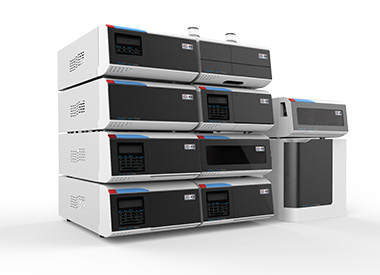Dual Mechanism of Separation
In pressurized capillary electrochromatography (pCEC), the retention mechanism is based on both chromatographic partition and electrophoresis. The dual mechanism of pCEC dramatically enhances the separation selectively, compared to the stand alone HPLC or CE system.
All in One
Modular design and flexible combination make it possible to run pCEC, μ-HPLC and CE on the same TriSep®-3000 system.

Friendly in Coupling with Different Detectors
Combined with on-column technologies, TriSep®-3000 pCEC system can be readily coupled with UV, LIF, EC, MS and other detectors. The pCEC technology is widely applied in various fields, including pharmaceutical, biotech, food and beverage, environmental applications.
Ultra Performance created by dual separation mechanism and small particles of 1.5 μm.
Pressurized capillary electrochromatography (pCEC) is based on dualmechanism of both chromatoghraphic partition and electrophoresis, chromatography particles in the capillary column and force given by electro-osmotic flow (EOF) and pressure. Contributed to the dual mechanism, pCEC makes the separation of charged and non-charged components possible.
With the existence of EOF, pCEC offers much better efficiency than that in HPLC.

Chromatography theory states that increasing efficiency will increase resolution. pCEC easily makes the application of small particles of 1.5μm possible, because EOF in pCEC does not produce back pressure as in HPLC system with small particles. For the same reason, pCEC system makes the application of longer column over 500 mm possible, which also increases the efficiency of separation.
solvent delivery system
Item Description Range 1 μL/min-10 mL/min Accuracy ±1% Precision 0.06% RSD Pressure range 1.0-40 MPa UV/vis detector
Item Description Light source deuterium lamp/tungsten lamp Wavelength range 190 ~ 700 nm Spectral bandwidth 8 nm Wavelength accuracy ±1 nm Wavelength reproducibility ±0.1 nm Drift 1×10-4 AU/h Noise level ±0.25×10-5 AU Range 0.0001 ~ 2.56 AUFS Light source life 2000 h Operating temperature range 4°C ~ 35°C Dimensions 260(W) 140(H) 430(D) mm High voltage power
Item Description Voltage range 0~±30 kV Current range 0~100 μA Maximum output power 4 W Weight 12 kg Working environment
working temperature 10℃—40℃ relative humidity ≤75% power supply 220V/110V±10% power frequency 50/60Hz±5% Pressurized capillary electrochromatography coupled with mass spectrometry(pCEC-MS)

Figure 1. pCEC-LIF Analysis of FITC-labeled Aliphatic Amines
Column: EP-100-20-3-C18
Mobile phase: 50%(v/v) ACN/50mM NH4Ac(pH 3.0)
Pressure: 1000 psi
Power voltage: 10 kV
Sample volume: 20 nL
Detector: MS, sheath flow, 3 μL/min 50% (v/v) CH3OH/0.5% CH3COOH; Sheath gas flow, 12 unit/min; ESI, 4.5 kV; Scan speed: 200-2000u.
Sample: a) Insulin modified; b) Insulin
(Ref. “Pressurized Electrochromatography Coupled with Electrospray Ionization Mass Spectrometry for Analysis of Peptides and Proteins”, Anal. Chem., 2004; 76,6935-6940. Zhen Liang, Jicheng Duan, Lihua Zhang, Yukui Zhang, Chao Yan.)
Pressurized capillary electrochromatography coupled with laser induced fluorescence detector (pCEC-LIF)

Figure 2. pCEC-LIF Analysis of FITC-labeled Aliphatic Amines
Column: EP-100-20-45-3-C18
Mobile phase:
A:10%(v/v) ACN + 10%40 mM PBS+H20
B:65%(v/v) ACN + 10%40 mM PBS+H20
Gradient: 0 – 30 min 100% A – 0%A
Pressure: 1500 psi
Power voltage:5 kV
Detector: LIF detector
Excitation: 473 nm
Emission: 520 nm
Sample: Aliphatic Amines C1 – C14 (peak 1to peak 14)
Drug

Figure 3. Separation of 6 opiate compounds in CEC
Column: EP-75-15-1.5-ODS
Mobile phase: 10 mM TRIS,5mMSDS/20% CH3CN
Power voltage: 20kV
Sample volume: 20 nL
UV: 215 nm
(Ref: “Separation ofrelated opiate compounds using capillary electrochromatography”,Electrophoresis, 21(4), 737, 2000, Lim,Jong-Tae; Zare,Richard N.;Bailey,Christopher G.; Rakestraw,David J.; Yan, Chao.)
Pressurized Capillary Electrochromatography
Product name:TriSep®3000 pCEC
Product model:TriSep®3000
Product overview
Ultra Efficiency : 250,000 theoretical plates/m
Ultra Speed : 4 compounds are baseline separated in less than 30 seconds
Ultra Peak Capacity : 3 times higher than HPLC
Ultra Reproducibility : Excellent reproducibility as in HPLC


 CHINESE
CHINESE


 Click to enlarge figure
Click to enlarge figure